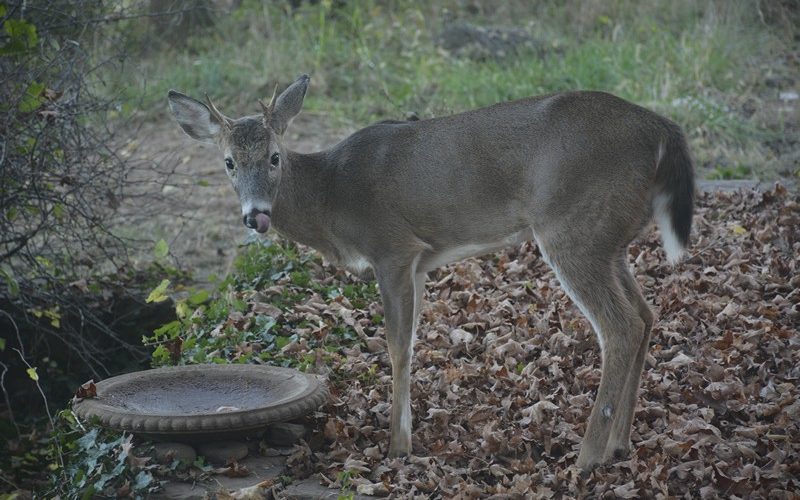
Courtesy Photo
A young buck outside Fayetteville enjoys a drink at a birdbath.
The “crunch rhythm” in the leaf litter suggested something large was approaching hesitantly. A glance out the back window revealed the mystery guest: a young thirsty buck was heading towards the birdbath. Wary but seemingly relaxed, he drank his fill and nudged the leaves around. Every now and again he would lift his head and glance around, licking his shiny black nose and flicking his feather duster tail. His visits have become happily regular this fall.
Birdbath visitors come in all sizes, from the tiny spring peeper to the black bear. Some thirsty guests in Northwest Arkansas include bees, songbirds, tree frogs, squirrels, chipmunks, and even a barred owl interested in taking a bath during a particularly dry season. Raccoons, opossums, rabbits and rodents enjoy the water, too, so a birdbath becomes a 24/7 watering hole. Don’t have a birdbath? That’s OK. Shallow dishes or a Frisbee full of pebbles work just fine.
Here are a few tips for making your birdbath the best it can be this winter: elevate it, keep it shallow, refill frequently, consider heating, and ensure rough sides with a gradual slope. Birdbaths on the ground make for a mixed blessing: small flightless wildlife will find it easier to access the water, but outdoor cats will find it easier to kill visitors to your birdbath. Especially if there are plenty of places for cats to hide around the birdbath, it’s better to elevate it off the ground. If you have a small outdoor pond, having places for the wildlife to hide (in and around the pond) is actually a good thing – they can jump under a leaf or dive into a deeper section of pond in order to escape a predator.
Keeping the birdbath shallow and only using baths with rough, textured sides can help birds and (in warmer months) pollinators to grip the surface with their little legs. Otherwise, they slip and find it difficult to stand. Shallow water is better for splashing than deep, and water that’s too deep would require some wildlife to swim. It’s best for them to be able to wade in gently. Shallow birdbaths also make it a habit to refill, since they take less water and tend to need refilled every day so there isn’t a temptation to leave dirty standing water for days. They will freeze faster, though. Consider heating your birdbath if possible; if not, placing it in a sunny spot may help at least a little. Even in ice and snow, wildlife need to drink water to survive. Little patches of water spread throughout a neighborhood can truly make a difference and bring a little holiday cheer to the wild ones.
Amanda Bancroft is a writer, artist, and naturalist building an off-grid cottage for land conservation on Mt. Kessler. She and her husband Ryan blog about their adventures and offer a solar-hosted online educational center on how to make a difference with everyday choices at: www.RipplesBlog.org










